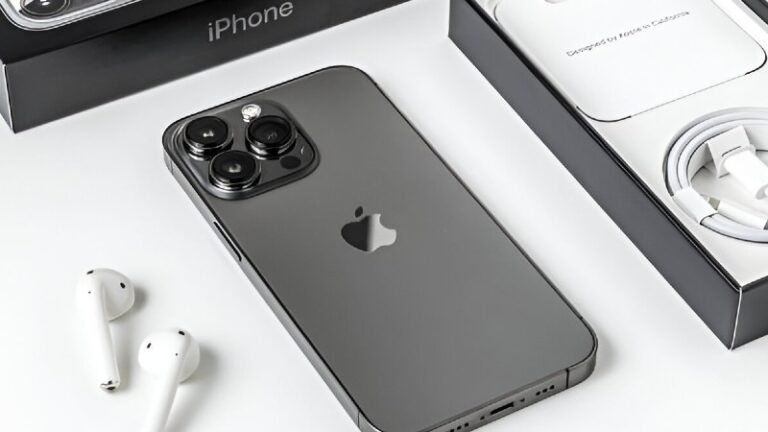The iPhone 17 Air isn’t just a thinner iPhone it signals a significant shift in Apple’s engineering philosophy. In a world where smartphone innovation often feels incremental, Apple appears ready to break that pattern with the release of its sleekest, lightest iPhone ever. But beneath the minimalist shell lies a complex rethinking of internal architecture, connectivity, and component integration. Here’s everything you need to know about the iPhone 17 Air and why it matters more than you might think.
iPhone 17 Air
| Feature | Details |
| Display | 6.6-inch OLED, ProMotion, Dynamic Island |
| Thickness | Approx. 5.5mm – 6.25mm |
| Weight | 145 grams |
| Camera | Single 48MP rear camera (center-aligned) |
| Processor | Custom Apple Silicon with C1 modem |
| Price | Expected from $1,049 |
The Air Naming Strategy
Borrowing the Air moniker from its MacBook and iPad lines, Apple is clearly signaling a product that prioritizes thinness, lightness, and portability. Unlike the Pro and Pro Max, which are associated with advanced features and larger size, the iPhone 17 Air represents elegant minimalism—a slim form factor without full-blown compromises.
Goodbye Plus, Hello Air
Interestingly, Apple is reportedly dropping the Plus model from the iPhone 17 lineup altogether to make space for the Air variant. This move highlights Apple’s shift away from sizing up to packing down—a decision likely driven by market data showing stagnant demand for mid-tier large-format phones.
Radical Design Changes Driven by Engineering
Creating a thinner iPhone isn’t simply about slicing off excess material. It demands rethinking every internal component. According to Bloomberg’s Mark Gurman, Apple undertook a herculean engineering effort to make this design work.
Display and Component Redesign
- Thinner OLED Panels: Apple is reportedly using a redesigned display stack with fewer layers and reduced backlighting components.
- Redesigned Motherboard: Apple engineers developed a more compact, possibly folded logic board to save space.
- Smaller Battery: While the battery size will be reduced, energy efficiency improvements from Apple Silicon and the new C1 modem help offset losses.
Subtle External Differences
From the front, the iPhone 17 Air may appear deceptively similar to the iPhone 17 base model. But a closer look reveals:
- USB-C port shifted slightly rearward
- Only two speaker grille holes on either side (down from five)
- New color options: light blue, gold, silver, black
A Center-Aligned Camera
Perhaps the most visually distinctive feature is the repositioned rear camera. Unlike all previous iPhones, the 17 Air is expected to feature a single, centered 48MP camera. This is more than a cosmetic change it allows for internal symmetry that aids in better heat distribution and space efficiency.
Tradeoffs to Watch
- No Telephoto or Ultrawide: The Air will not feature additional lenses found in the Pro models.
- Limited mmWave 5G: The C1 modem sacrifices ultra-fast 5G support for improved battery life and efficiency.
- Global eSIM: Apple is fully eliminating the physical SIM tray across all markets in this model.
Pricing
According to Jefferies analyst Edison Lee, the iPhone 17 Air will debut at $1,049, about $50 more than what a Plus model might have cost. Apple attributes this to increased component prices and shifting tariffs in China, but the design overhaul also justifies the bump.
Comparative Pricing Table
| Model | Starting Price (USD) |
| iPhone 17 | $799 |
| iPhone 17 Pro | $1,049 |
| iPhone 17 Pro Max | $1,249 |
| iPhone 17 Air | $1,049 |
iPhone 17 Air as a Future-Proof Prototype
What makes the iPhone 17 Air truly intriguing isn’t what it includes—but what it leads to. Industry insiders believe Apple is using the Air as a blueprint for future ultra-thin, flexible devices. The engineering solutions pioneered here could lay the groundwork for:
- Foldable iPhones
- Modular wearables
- Advanced AR integration with lighter hardware
Like the original MacBook Air, which seemed underpowered in its debut but became a dominant category, the iPhone 17 Air might not be for everyone right now. But it shows us exactly where Apple is headed.
Conclusion
If you’re an iPhone user who values portability, aesthetic design, and cutting-edge efficiency over camera flexibility and full network support, the iPhone 17 Air could be your ideal device. But it’s also a symbol of something larger: Apple’s willingness to redefine the smartphone experience once again starting not with power, but with precision engineering.
Frequently Asked Questions (FAQs)
What is the iPhone 17 Air?
The iPhone 17 Air is Apple’s upcoming ultra-thin iPhone model, expected to debut in 2025. It features a 6.6-inch OLED display, a lightweight design, and a centered single rear camera.
How thin is the iPhone 17 Air?
The iPhone 17 Air is rumored to be between 5.5mm and 6.25mm thick, making it the thinnest iPhone ever created by Apple.
How much will the iPhone 17 Air cost?
According to analyst reports, the iPhone 17 Air will start at $1,049, reflecting a $50 price increase compared to previous models due to rising component costs and new design elements.
What camera does the iPhone 17 Air have?
It will feature a single 48MP rear camera positioned in the center of the device. This change helps accommodate internal components in the slim chassis.
Will the iPhone 17 Air support mmWave 5G?
No, the iPhone 17 Air is expected to use Apple’s new C1 modem, which improves efficiency but drops mmWave 5G support.
Is the iPhone 17 Air replacing the iPhone Plus model?
Yes, Apple is reportedly dropping the iPhone Plus variant in favor of the iPhone 17 Air, focusing instead on a slimmer, lighter form factor.
Will the iPhone 17 Air have a SIM card slot?
Apple is expected to eliminate the SIM card tray entirely from the iPhone 17 Air, even in markets where physical SIMs were previously available.


